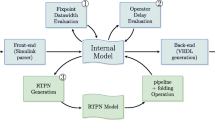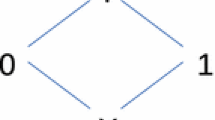Abstract
Speed-independent circuit design is of increasing interest because of global timing problems in VLSI. Unfortunately, speed-independent design is very subtle. We propose the use of statemachine verification tools to ameliorate this problem. This article illustrates issues in the modeling, specification, and verification of speed-independent circuits through consideration of self-timed queues. User-level specifications are given as Petri nets, which are translated into trace structures for automatic processing. Three different implementations of queues are considered: a chain of queue cells, two parallel chains, and a “circular buffer” example using a separate RAM.
Similar content being viewed by others
References
R. Alur, C. Courcoubetis, and D. Dill. Model-checking for real-time systems. In Proceedings of the Fifth Annual IEEE Symposium on Logic in Computer Science, IEEE Computer Society, Philadelphia, PA, June 4–7, 1990, pp. 414–425.
R. Alur and D. Dill. Automata for modeling real-time systems. In Automata, Languages and Programming: 17th Annual Colloquium. Lecture Notes in Computer Science, 443: 322–335 (July 16–20, 1990).
J.R.Burch. Combining CTL, trace theory, and timing models. In Automatic Verification Methods for Finite State Systems, J.Sitakis (ed.). Lecture Notes in Computer Science, 407: 334–348, Springer-Verlag, New York, 1989.
J.R. Burch, E.M. Clarke, K.L. McMillan, D.L. Dill, and L.J. Hwang. Symbolic model checking: 1020 states and beyond. Information and Computation (1992). To appear.
T.-A. Chu. Synthesis of self-timed VLSI circuits from graph-theoretic specifications. Technical Report MIT-LCS-TR-393, MIT, 1987.
O.Coudert, C.Berthet, and J.C.Madre. Verification of synchronous sequential machines based on symbolic execution. In Automatic Verification Methods for Finite State Systems, J.Sifakis (ed.). Lecture Notes in Computer Science, 407: 365–373, Springer-Verlag, New York, 1989.
D.L.Dill. Trace theory for automatic hierarchical verification of speed-independent circuits. In Advanced Research in VLSI: Proceedings of the Fifth MIT Conference, Jonathan Allen and F. Thomson Leighton, (ed.). MIT Press, Cambridge, MA, 1988.
D.L.Dill. Timing assumptions and verification of finite-state concurrent systems. In Automatic Verification Methods for Finite State Systems, J.Sifakis (ed.). Lecture Notes in Computer Science, 407: 197–212, Springer-Verlag, New York, 1989.
D.L.Dill. Trace Thoery for Automatic Hierarchical Verification of Speed-Independent Circuits. MIT Press, Cambridge, MA, 1989.
D.L.Dill and E.M.Clarke. Automatic verification of asynchronous circuits using temporal logic. IEE Proceedings, Pt. E, 133(5): 276–282 (September 1986).
P.Godefroid. Using partial-order methods to improve automatic verification methods. In Computer-Aided Verification, '90. DIMACS Series in Discrete Mathematics and Theoretical Computer Science, 3: 321–340. American Mathematical Society, Providence, Rhode Island, 1990.
M.Gordon. HOL: a proof generating system for higher-order logic. In VLSI Specification, Verification and Synthesis, G. Birwistle and P.A. Subrahmanyam (ed.). Kluwer Academic Publishers, Boston, 1988.
C.A.R. Hoare, A model for communicating sequential processes. Technical Report PRG-22, Programming Research Group, Oxford University Computing Laboratory, 1981.
J.E.Hopcroft and J.D.Ullman. Introduction to Automata Theory, Languages, and Computation. Addison-Wesley, Reading, MA, 1979.
W.A.HuntJr. The mechanical verification of a microprocessor design. In From HDL Descriptions to Guaranteed Correct Circuit Designs, D.Borrione (ed.). North Holland, Amsterdam, 1987.
R.P.Kurshan. Analysis of discrete event coordination. In Stepwise Refinement of Distributed Systems: Models, Formalisms, Correctness. REX Workshop Proceedings. Lecture Notes in Computer Science, 430: 414–453, Springer-Verlag, New York, 1990.
L. Lavagno, K. Keutzer, and A. Sangiovanni-Vincentelli. Algorithms for synthesis of hazard-free asynchronous circuits. In 28th ACM/IEEE Design Automation Conference, San Francisco, California, June 17–21, 302–308, 1991.
H.R. Lewis. A logic of concrete time intervals (extended abstract). In Proceedings of the Fifth Annual IEEE Symposium on Logic in Computer Science, IEEE Computer Society, Philadelphia, PA, June 4–7, 1990, pp. 380–389.
A.Mazurkiewicz. Basic notions of trace theory. In Linear Time, Branching Time and Partial Order in Logics and Models for Concurrency. Lecture Notes in Computer Science, 354: 285–363, Springer-Verlag, New York, 1989.
Teresa H.-Y. Meng, Robert W. Brodersen, and David G. Messerschmitt. Automatic synthesis of asynchronous circuits from high-level specifications. In IEEE Transactions on CAD, 8(11): 1185–1205 (November 1989).
C.E.Molnar, T.-P.Fang, and F.U.Rosenberger. Synthesis of delay-insensitive modules. In 1985 Chapel Hill Conference on Very Large Scale Integration, HenryFuchs (ed.). Computer Science Press, Rockville, Maryland, 1985, pp. 67–86.
S.S. Patil. An asynchronous logic array. Technical Report Technical Memorandom 62, Massachusetts Institute of Technology, Project MAC, 1975.
J.L.Peterson, Petri Net Theory and the Modeling of Systems. Prentice-Hall, Englewood Cliffs, NJ, 1981.
D.K.Probst and H.F.Li. Using partial-order semantics to avoid the state explosion problem in asynchronous systems. In Computer-Aided Verification, '90. DIMACS Series in Discrete Mathematics and Theoretical Computer Science, 3: 15–24. American Mathematical Society, Providence, Rhode Island, 1990.
M.Rem, J.L.A.van deSnepscheut, and J.T.Udding. Trace theory and the definition of hierarchical components. In Third CalTech Conference on Very Large Scale Integration, RandalBryant (ed.). Computer Science Press, Rockville, Maryland, 1983, pp. 225–239.
C.L. Seitz. Ideas about arbiters. Lambda, 10–14 (First Quarter, 1980).
I.E.Sutherland. Micropipelines. Communications of the ACM, 32(6): 720–738 (June 1989).
J.T. Udding. Classification and Composition of Delay-Insensitive Circuits. Ph.D. thesis, Department of Computing Science, Eindhoven University of Technology, September 1984.
J.T.Udding. A formal model for defining and classifying delay-insensitive circuits and systems. Distributed Computing, 1(4): 197–204 (1986).
A.Valmari. A stubborn attack on state explosion. In Computer-Aided Verification, '90. DIMACS Series in Discrete Mathematics and Theoretical Computer Science, 3: 25–42. American Mathematical Society, Providence, Rhode Island, 1990.
P. Vanbekbergen. Optimized synthesis of asynchronous control circuits from graph-theoretic specifications. In IEEE International Conference on Computer-Aided Design, IEEE Computer Society, Santa Clara, CA, November 11–15, 1990, pp. 184–187.
Author information
Authors and Affiliations
Rights and permissions
About this article
Cite this article
Dill, D.L., Nowick, S.M. & Sproull, R.F. Specification and automatic verification of self-timed queues. Form Method Syst Des 1, 29–60 (1992). https://doi.org/10.1007/BF00464356
Issue Date:
DOI: https://doi.org/10.1007/BF00464356




